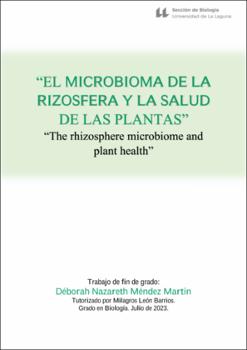El microbioma de la rizosfera y la salud de las plantas
Date
2023Abstract
Las plantas no deben ser consideradas como entidades independientes, se requiere una
visión holística que contemple la diversidad de microorganismos asociados a sus tejidos que son esenciales para su buena “salud”, entendida como un buen crecimiento, adaptación al medio físico y lucha frente a patógenos. Lo sorprendente de estos holobiontes es la existencia de una
compleja red de interacciones genéticas y metabólicas microorganismos-planta, que le otorga la capacidad a los vegetales de modular la microbiota adecuándola a sus necesidades. La microbiota del suelo es la “cantera” a partir de cual la planta configura el microbioma de la rizosfera, que se consideran como el “segundo genoma de los vegetales” debido a su gran importancia en funciones tan trascendentes como la estimulación del crecimiento mediante la producción de fitohormonas, la mejora de la nutrición del vegetal (aportando directamente de
nutrientes o facilitando su toma), la resistencia frente a estreses abióticos y la inducción de una respuesta inmune sistémica que le facilita su supervivencia ante el ataque de patógenos.
El conocimiento de la diversidad y composición de las comunidades microbianas asociadas a la rizosfera de plantas, de los mecanismos que rigen su selección y de las actividades que desempeñan en la rizosfera brindará oportunidades para implementar metodologías que favorezcan el rendimiento en los sistemas de producción vegetal y crear así una alternativa más sostenible a la fertilización química (altamente contaminante) usada tradicionalmente para
mejorar la producción agrícola y combatir los fitopatógenos. En este TFG hacemos una revisión actualizada de los conocimientos sobre el microbioma de la rizosfera, abordando aquellos relacionados con la promoción directa del crecimiento
vegetal y también los que están implicados en la respuesta frente a patógenos. Plants should not be considered as independent entities, a holistic vision is required that contemplates the diversity of microorganisms associated with their tissues, where they’re essential for their good “health”, understood as a good growth, adaptation to the physical environment and fight against pathogens. What is surprising about these holobionts is the existence of a complex network of genetic and metabolic microorganism-plant interactions,
which gives plants the ability to modulate the microbiota to suit their needs. The soil microbiota is the “quarry” from which the plant configures the microbiome of the rhizosphere, which are considered as the “second plant genome” due to its great importance in such trascendental functions as stimulating growth through the production of phytohormones, enhancing the nutrition of the plants (directly providing nutrients or facilitating their intake), resistence to
abiotic stresses and the induction of a systemic immune response that facilitates its survival against the attack of pathogens.
Knowledge of the diversity and composition of microbial communities associated with the
rhizosphere of plants, the mechanisms governing their selection and their activities in the rhizosphere will provide opportunities to implement yield-enhancing methodologies in plant production systems and create a more sustainable alternative to chemical fertilization (highly polluting) traditionally used to improve agricultural production and deal with plant pathogens. In this TFG we make an updated review of the knowledge about the rhizosphere microbiome, addressing those related to the direct promotion of plant growth and also those involved in the response to pathogens.




